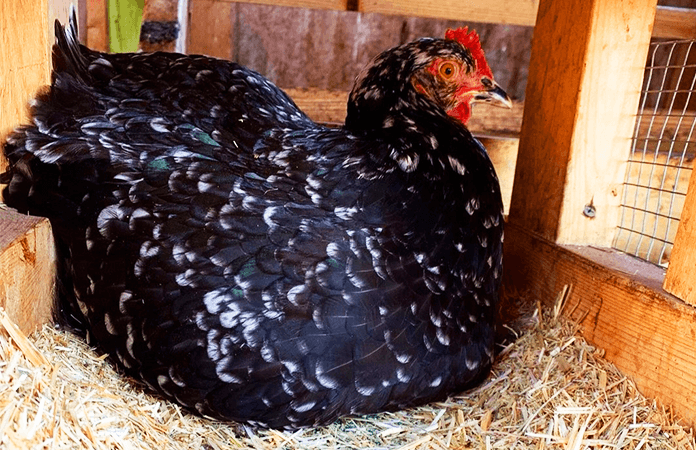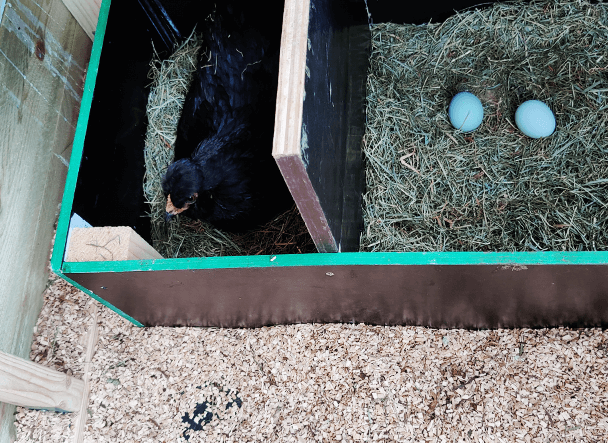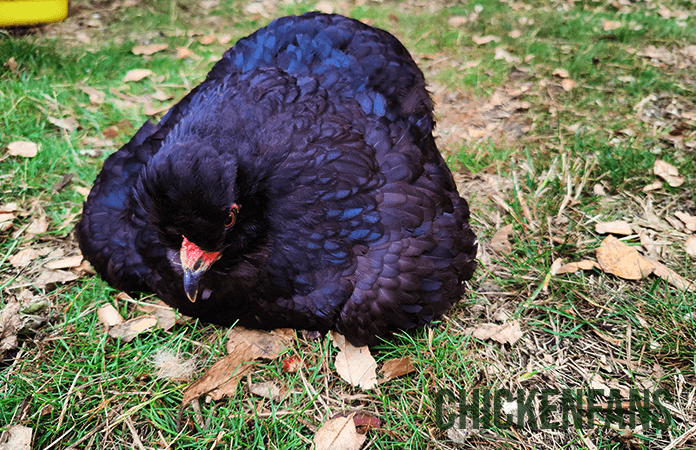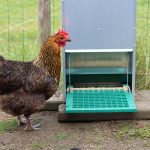SOS Broody Hen: 8 Ways To Stop Broodiness In Chickens

It’s a common frustration among chicken owners: a hen refusing to leave the nest, desperate to hatch eggs, even if no eggs are found. Not only can broodiness be dangerous for your chicken, but it also temporarily stops egg production.
Let’s find out how to solve broodiness in chickens and how to deal with a broody hen.
- Choose the right breed
- Check on your chickens regularly
- Take the hen off the nest
- Close the coop or nesting box access
- Separate the broody hen
- Distract her with treats and activities
- Give her a water bath
- Let her hatch fertilized eggs
1. Choose the right breed
Not all chicken breeds quickly go broody; there are a lot of breeds to be found that are known to (almost) never go broody. If you’re not planning on hatching chicken eggs and are just looking for a daily egg supply, it’s best to choose a breed that’s not known for its broodiness. After all, egg production will stop during broodiness.
All chicken breeds vary from non-sitters to extremely broody, but it also depends from chicken to chicken. Non-sitters are not likely to go broody, but this doesn’t mean it’ll never happen. Always remember that chickens are animals that’ll follow their natural instincts.
Breeds that seldom go broody:
- Polish chicken
- Ancona
- Sagitta
- Sebright
- Plymouth Rock
- Rhode Island Red
- White or Brown Leghorn
- Andalusian
- White Faced Black Spanish
- Hamburg
- Minorca
- Malay
- Green Queen
- Lakenvelder
- Vorwerk
The list of non-sitters can be longer than the one we’re addressing here; we’ve only included fairly common breeds. If you’re looking for a non-sitter, choose a Mediterranean breed or a hybrid bird bred to produce many eggs but not to sit. Sitting abilities can, however, differ from bird to bird; there’s no exact science.
Go to our ‘Breed Page’ to explore all kinds of different breeds.
Breeds That are occasionally Broody:
- Ameraucana
- Faverolles
- Australorp
- Calico Princess
- Langshan
- Mystic Onyx
- Appenzeller
- Cinnamon Queen
- Jersey Giant
- Cornish (Indian Game)
- Wyandotte
- Delaware
- Sussex
Chickens will be chickens, and most chickens will stay on their eggs from time to time. But breaking the habit and stopping the broodiness is relatively easy in all these breeds.
Breeds that frequently go broody:

Silkies and Cochin chickens are known to be the world’s broodiest chickens. New chicken keepers often overlook their broodiness because they’re mainly kept as pet chickens because of their fluffy look and sweet nature.
This can cause annoying situations as both Silkies and Cochin can be very stubborn during broodiness, refuse to leave the nest, and even forget to eat and drink.
2. Check on your chickens regularly
The sooner you catch your chicken being broody, the easier it’ll be to break the habit. It’s not that uncommon, especially when keeping multiple chickens, that you won’t notice it immediately if a hen stays in the nesting box.
Check your chickens a couple of times a day, look inside the nesting boxes and verify whether they’re not staying there. A hen solely sits inside a nesting box to lay eggs and leaves as soon as she’s done. If the same hen stays there for hours, you’ll know something is up.
A broody hen is easily recognizable. She doesn’t like to be disturbed and will start to make grumbling noises and fluff up her feathers when you approach her. Our Araucana hen was broody multiple times during summer, and her behavior was obvious.
Here’s a video of a broody Araucana hen:
3. Take the broody hen off the nest
Once you’ve spotted broody behavior, you must not let it get out of hand and act immediately. Take the broody hen off the nest and place her with other flock members. You can shield off the coop entrance if necessary so she can’t run back immediately.
Check whether there are any eggs left in the nesting box and collect them if there are. It’s important not to leave eggs inside a broody hen’s nest.
With the broody hen outside, surrounded by fellow flockmates, she’ll soon eat and drink en maybe even roam around. If you catch the broodiness in an early stage, taking her off the nest frequently will suffice to stop her from staying on the nest.
4. Close coop or nesting box access
This one is quite tricky as it’s easier said than done, especially when keeping a large chicken flock. The main projective is to keep your broody hen out of the nesting boxes but still allow access for other chickens. Not an easy task, but doable if you have the time to devote to it. Or, only use this tip when you’re sure all other chickens have already laid that day. An automated chicken coop door can help you with the task.
Ensure your broody chicken can never access the nesting boxes by closing the coop door or blocking the way to the nesting boxes. But this also means you’ll have to go and check your other hens frequently and allow them access once you notice they want to go inside. You’ll be their personal doorman! At least for a couple of days.

This solution is our least favorite, as it takes a lot of time and demands plenty of attention. But if you’re not up to separating the broody hen and if you catch the broodiness in an early stage, this is an effective way to stop your hen from being broody without making major adjustments.
5. Separate the broody hen
Have you ever heard the term: ‘Broody Jail’? It’s a reference used by many chicken keepers on social media talking about separating their broody hen from the rest of the flock. Broody jail is not far from the truth; you only provide minimum space requirements and access to food and water, nothing else.
Some chicken keepers keep their broody hen inside the improvised jail for a couple of days, even during nighttime, but we suggest letting her out of ‘jail’ a couple of times a day. You can place her back when noticing she goes back to the nesting boxes.
Most people use this method if their chicken stays broody even after taking her off the nest frequently. The longer the broodiness lasts, the harder it is to snap her out of it, so you’ll need to act fast.
Broody jail requirements:
- Food and water access
- Keep her visible to other flock members
- Provide shelter and shade
- Let her out a couple of times a day
- Place her inside the coop with the others at nighttime
- Don’t lock her up longer than necessary

A broody hen separated from the nesting box will probably sit on the ground for most of the day. Once you notice she’s standing up and walking around, let her out of broody jail to try and see if she’ll join the rest of the flock instead of running to the nesting box.
Don’t keep her locked up longer than necessary.
6. Distract with treats and activities
A great way to distract your broody hen from wanting to go to the nesting box is by providing activities and treats. Or combine the two by making them work for their snacks by hanging a lettuce pinata or hiding mealworms in a food ball. Maybe your broody hen won’t join in on the fun, but she’ll be distracted by seeing the others keeping busy.
If you’re not sure your broody hen is eating or drinking enough, it’s best to separate her from the flock so you can monitor food and water intake. Spoil her with tasty fruits or mealworms or anything she likes best. But be careful not to overdo it, and switch back to regular feed as soon as possible. A chicken’s daily feed may never exist in more than 10% of snacks.

7. Give a Water Bath
Have you ever felt a broody chicken’s belly? It’s hot! Their warm skin keeps the eggs warm, and it’s also not uncommon for them to lose their chest feathering. You lower their body temperature by giving them a water bath, which helps to stop broodiness.
Chickens don’t like water baths; they don’t need them. They clean themselves by dust bathing and preening. The only reason to give a chicken a water bath is to soak dirty (vent) feathers or, in case of fly strike. Giving a broody hen a water bath is solely used to lower the body temperature.
Never bathe your chicken in cold water; only use lukewarm water. You can let them dry in the open air when the outside temperature is warm. If you’re bathing your chicken during colder weather, use a hairdryer to ensure all feathers are dry before sending her back to the coop. Use low heat and low ventilation if you use a hairdryer.
8. Let her hatch fertilized eggs
The most efficient way to stop broodiness is to let her hatch eggs and become a mother. But we only recommend this if you’ve thought this through and have the space and requirements to care for baby chicks. It’s a beautiful process to observe, especially when you have kids. But remember that small chicks become big, and some of them are going to be roosters.
However, this helps the broodiness; it’s only a temporary solution. Hens will become broody again once their chicks are grown up.
Summary
A broody hen can be a real frustration for many chicken keepers. They refuse to leave the nest, are grumpy, and stop laying eggs. If you’re not planning to hatch eggs, breaking her out of the egg-sitting habit is best. There are plenty of things to try, but not allowing her to sit on eggs or inside the nesting box is critical. You can separate her from the rest of the flock or close the coop access.
If you are not planning on hatching eggs and don’t want a broody hen to stress about, look at our extensive list of non-sitters. These breeds are less likely to go broody, so you won’t have to worry about it in the first place.
Credits Featured Image: @4_oaks_ranch (IG)






















